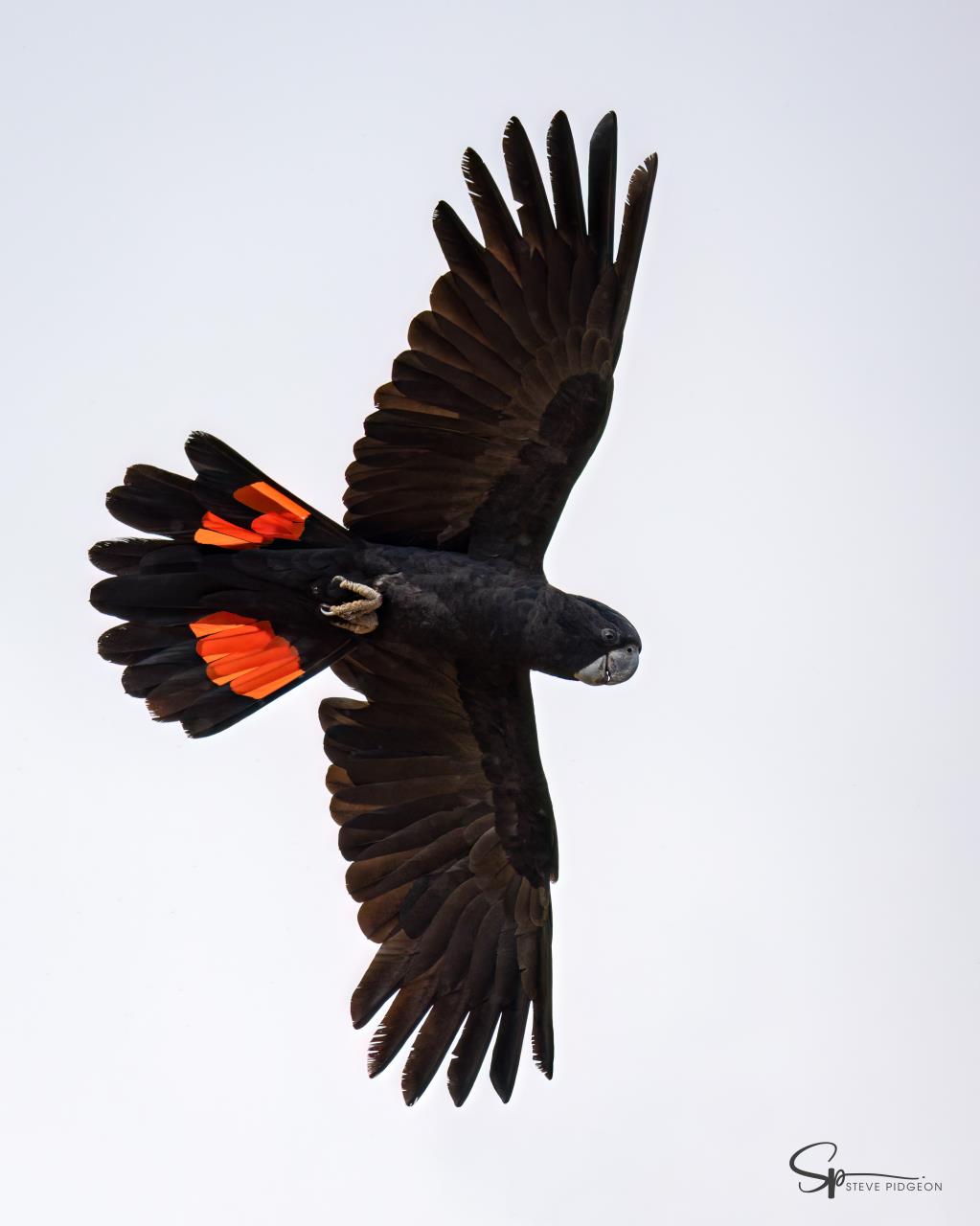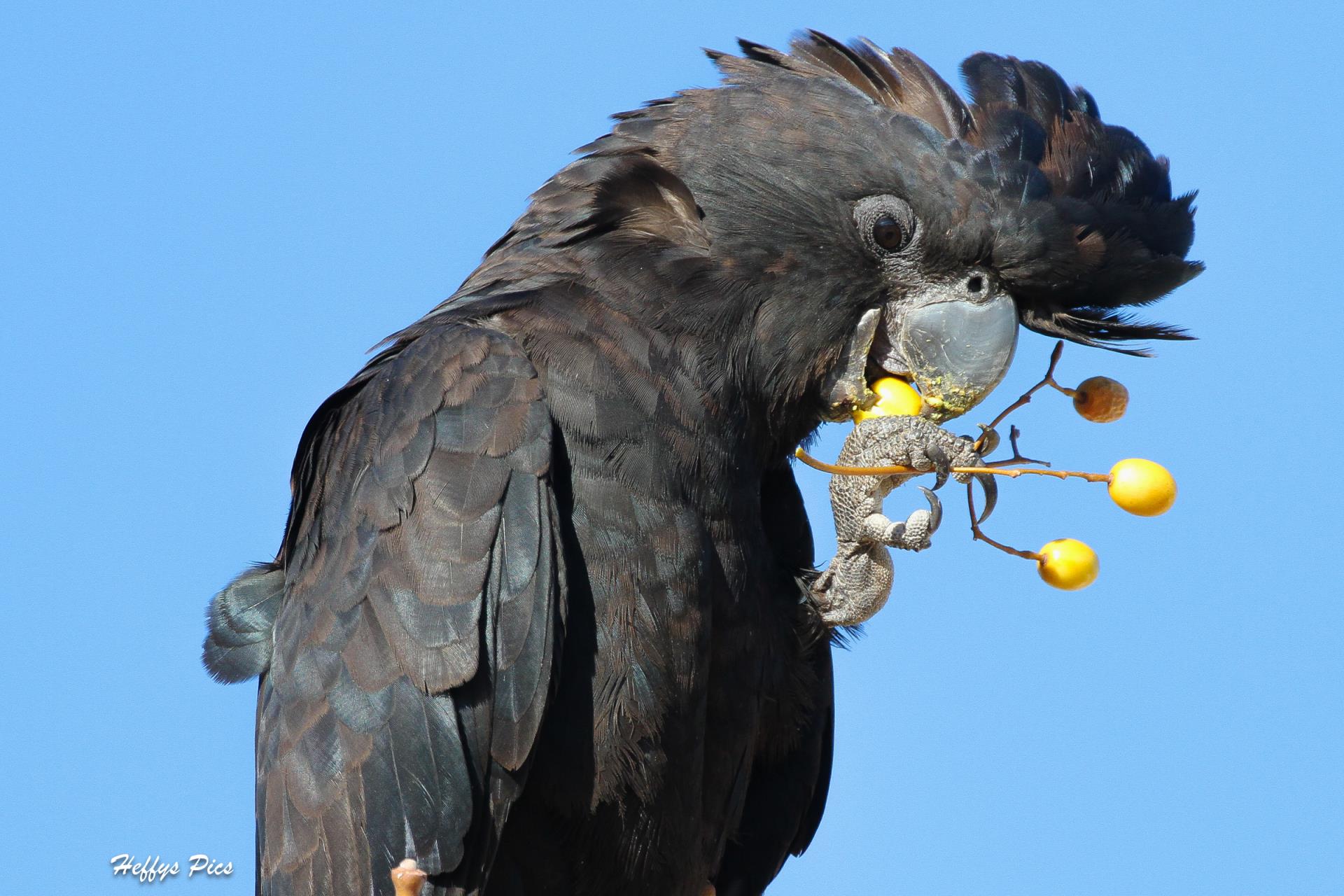Red-Tailed Black Cockatoo

Photo courtesy of Steve Pidgeon
Many people will have seen (and definitely heard) Red-tailed black cockatoos flying overhead, or feeding high up in trees, but did you know that we have our very own species of Red-tailed black cockatoo here in the Midwest?
Across Australia there are five species of Red-tailed black cockatoos, three sub-species are located within Western Australia, the local Midwest sub-species has the Scientific name of Calyptorhynchus banksii escondidus, more commonly known as the Western red-tailed black cockatoo.
The five taxa (sub-species) are:
Northern Red-tailed Black Cockatoo (Calyptorhynchus banksii banksii) occurs in the Kimberley, north of the Northern Territory, north and coastal Queensland (Of least concern).
- South-eastern Red-tailed Black Cockatoo (Calyptorhynchus banksii graptogyne) occurs in south-eastern South Australia and western Victoria (Endangered)
- Forest Red-tailed Black Cockatoo (Calyptorhynchus banksii naso) occurs from Perth south through the forests of SW Australia (Vulnerable)
- Inland Red-tailed Black Cockatoo (Calyptorhynchus banksii samueli) occurs in central Australia and central and western New South Wales (Of least concern).
- Western Red-tailed Black Cockatoo (Calyptorhynchus banksii escondidus) – occurs in the Pilbara, Murchison, Gascoyne and northern WA wheatbelt (Of least concern). Only the Western Red-tailed Black Cockatoo occurs in the Northern Agricultural Catchment Council region including Geraldton.
Where are they Found?
Western Red-tailed black cockatoos are found in the arid and semi-arid riparian zones where they nest in hollows and feed on seeds on the associated riverine plains. Being seed eaters they must have access to water daily. With the development of the wheatbelt they have expanded their range south occupying much of the northern wheatbelt. They are semi-migratory moving away from their breeding areas to a distance of up to 200 kms. They have been observed in large numbers at Walkaway near the river, the Museum at Phillips Road and surrounding farmland and in the Chapman Valley. They have also been observed at Three Springs, Carnamah and the wheatbelt areas to the east of Geraldton.
Diet
The Red-tailed black cockatoos forage for food over an area of up to 20kms and require easy and close access to water. They feed almost exclusively on seed, including Doublegees in the wheatbelt and pastoral areas. The Western red-tailed black cockatoos in the Geraldton region have been observed feeding on Cape Lilac, Sheoaks and variety of Eucalyptus and Banksia and can often be heard flying in large groups around town.

Photo courtesy of Heather Beswick
Breeding
Red-tailed Black Cockatoos may mate for life and conduct an elaborate courtship. The male bows his head, spreading his wings out and fanning his beautiful red tail to attract the attention of a female. He will also call softly to the female. The cockatoos build a nest in large tree hollows, which are selected by the female. Two main breeding seasons occur, in February to May and July to October. The female usually lays one egg, rarely two. Incubation period is 29 days, and young fledge at around 70-85 days. Immature birds will stay with their parents for up to two years after fledging. Adults may have two young from two previous breeding seasons accompanying them.
Photos courtesy of Heather Beswick
Interesting Cockatoo facts
- Red-tailed black cockatoos nest in trees that must be at least 150 years old and large enough to support a large enough hollow.
- They line the floor of their nest hollow with wood chips, and other debris found in the trunk of the tree.
- Nest hollows have been found in Salmon Gums, York Gums and River Red gums.
- Males are black with distinctive red subterminal (stripe before tip of tail) bands in their tails and a black or dark grey coloured bill.
- Females are black with yellow spots on their wings, the breast and belly barred with orange-yellow and the tail band narrowly barred with orange – yellow, their bill is pale grey.
- Juveniles are similar to the female except for less pale-yellow spots on head, cheeks and wings with dull pale-yellow bars on breast and belly.
Threats
The main threat to cockatoos is habitat loss and degradation due to urban expansion and intensive clearing for agriculture. Extensive forest clearing of former habitat, has led to a reduction in the availability of large trees, therefore a lack of nesting hollows. Similarly, loss of foraging habitat has resulted in flocks having to travel further to feed.
The other main threats to cockatoos are competition from native and introduced species that compete for the nest hollows, such as galahs, corellas and bees. Other threats include vehicle strikes and predation of eggs by other species.
What you can do to help
- Protect and conserve large trees that may provide nesting hollows, even old and dead trees can provide habitat for nesting cockatoos.
- Plant local, native shrubs and trees that provide forage for cockatoos.
- Report sightings of pest species such as corellas and honeybees that compete for nest hollows.
- Volunteer at tree planting events, such as “National Tree Day” or at your local nursery (this will help many native species, not just cockies!)
- Consider making a donation to the Kaarakin Black Cockatoo Conservation Centre who are working hard to protect our threatened black cockatoos by rehabilitating injured birds and releasing them back to the wild. blackcockatoorecovery.com
- Contact Kaarakin on 08 9390 2288 if you find a sick or injured cockatoo or WA Wildcare Helpline on 08 9474 9055
- Record when, where and what we are doing when you see us. Get in touch with NACC (Northern Agricultural Catchment Council) if you have cockatoos on your property.
- Join Birdlife at www.birdlife.org.au and support all our birdlife through events such as the Great Cocky Count.
Red-tailed Black Cockatoos are magnificent birds and there are lots of amazing people working tirelessly to ensure they have a future and flying forever in our skies.
References/acknowledgements
The City would like to thank Heather Beswick and Steve Pidgeon from Birdlife Midwest Geraldton, Denis Saunders and Rick Dawson and Peter Mawson for their valuable input and information.
Kaarakin Black Cockatoo Centre. https://blackcockatoorecovery.com/types-of-black-cockatoos/